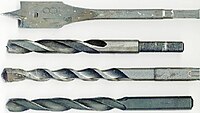
Photo from wikipedia
A frequently used mechanical joining process that enables the joining of dissimilar materials is self-piercing riveting. Nevertheless, the increasing number of materials as well as material–thickness combinations leads to the… Click to show full abstract
A frequently used mechanical joining process that enables the joining of dissimilar materials is self-piercing riveting. Nevertheless, the increasing number of materials as well as material–thickness combinations leads to the need for a large number of rivet–die combinations as the rigid tool systems are not able to react to changing boundary conditions. Therefore, tool changes or system conversions are needed, resulting in longer process times and inflexibility of the joining processes. In this investigation, the flexibility of the self-piercing riveting process by reducing the required tool–geometry combinations is examined. For this purpose, various joints consisting of similar as well as dissimilar materials with different material thickness are sampled and analysed. Subsequently, a cluster algorithm is used to reduce the number of rivet–die combinations required. Finally, the effect of the changed tool geometries on both the joint formation and the joint load-bearing capacity is investigated. The investigation showed that a reduction by 55% of the required rivet–die combinations was possible. In particular, the rivet length influences the joint formation and the joint load-bearing capacity. An exclusive change of the die (e.g. die depth or die diameter) did not show a significant influence on these parameters.
Journal Title: Proceedings of the Institution of Mechanical Engineers, Part L: Journal of Materials: Design and Applications
Year Published: 2022
Link to full text (if available)
Share on Social Media: Sign Up to like & get
recommendations!